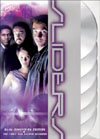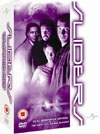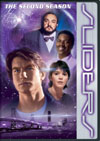This episode isn't bad at all, providing a decent level of intrigue and action throughout that is hard to memorize and get bored of, but yet it never really stakes a claim of uniqueness on any of its elements, including its cast of characters. Thematically, it covers a bit of the same ground as last year's "The Prince of Wails" (story no. 3), yet does the subject far greater justice. Writer Jacob Epstein definitely does far better work here than in his previous collaboration on "Eggheads" (story no. 6).
The repeated opening scenario plays out as something you'd sooner expect from a time-travel story. However, as time travel of this nature would naturally involve branching "parallel" universes, and writers often neglect to notice this, "Time Again and World" probably stays a step ahead of the game by doing it with parallel universes in the first place, one being just a tad later than the other so that the sliders have a chance to witness both. In keeping with the series format, these two worlds have their own unique quirks, but these remain superficial visual things. Bearded-women world is a throw-away idea that wasn't ever really going to go anywhere, while Police-in-skirts world has a scene or two of backstory to help plausibility, without becoming an idea that was going anywhere either. This episode is unique in that we don't really come out and meet any of the guest characters properly when we first see them. The story instead thrives on the fact that we only see snippets of them now and then, allowing the sliders and the audience to form impressions of them, accurate or not, and wonder who they are, how they fit in, and what their true agenda may be. Much of the early mystery is fueled primarily by visuals and action, with minimal dialogue, something more akin to feature films than television. It makes a nice change and is fairly well done this time around. The episode has its share of familiar faces. Gomez Calhoun is back, getting perhaps the only on-screen mention of his character's name in the entire series. Don't think you've got him pegged though; he remains as mysterious as any of the other shifty-visuals guest characters. Gary Jones is also back as the computer store boss, giving us another dose of his nerdy smugness. It's a bit of a wonder, at least for long-term followers of the show, how Quinn and Wade don't bump into doubles of themselves in the store, but at least Rembrandt is quick enough to prevent Jones from remembering them, if indeed he would have recognized them at all. The main plot goes through many points and angles, keeping up a quick pace full of fresh clues and interesting scenes. The action is fairly decent, achieving a lot of tension without going overboard, and remaining quite unpredictable. Nice. The concluding dynamics are a bit cliché and underwhelming though. Prisoner exchanges, particularly involving easily copyable information, drag all kinds of character motivation and believability into question. And it's plain dull as well. Plus, considering how things eventually turn out, you have to wonder how the sliders aren't lying through their teeth - never a good dynamic for protagonists anywhere, let alone during concluding manoeuvres. Wade really is the chief protagonist in this story, while the other three sliders provide support for her. There's a very good scene emphasizing this point when the three men all walk out on her, determined to leave this world to its problems, and they all eventually turn around to rejoin Wade and follow her example of making a heroic difference. All very reminiscent of Barbara Wright's effect on the Doctor in the earliest episodes of Doctor Who, before the Doctor's own heroic impulse began to lead the show. Good stuff. Quinn's heroics are on solid footing afterwards, but limited to the action in the middle of the story. The story's final moves are masterminded by Wade and carried out by Rembrandt. Quinn's participation at the end goes a bit off-colour, trading useless insults with an antagonist of minor proportions. He does get in a nice line about people not having read the U.S. Constitution - too many documents go unread, and are then allowed to govern our lives as it is. Maybe we shouldn't really need anything grand out of Quinn during a Wade episode, but Quinn has yet to achieve any last minute heroics that are motivated beyond his immediate group of four sliders continuing their journey..... But it is the final "coda" scene that really steals the show, and is probably the most memorable scene ever for Gary Jones' character(s) on Sliders. There is so much good stuff in this tiny little snippet. It shows the futility of trying to suppress information, and showcases the promise of the internet which was still in its early infancy when this episode was made. The Star Trek episode "The Omega Glory" can truly eat its heart out, as this Sliders story blows it away in terms of using the U.S. Constitution in a believable and emotionally powerful way. And the gathering around Gary Jones' monitor is as diverse in gender, age, and ethnicity as Star Trek ever aspired to be. Good one. The closing graphic is cool too, and will later be imitated on the big screen at the end of the feature film "The Core".
This story has become available on DVD. Click on the Amazon symbol for the location nearest you for pricing and availability:
Comments on this article are welcome. You may contact the author from this page:
|









